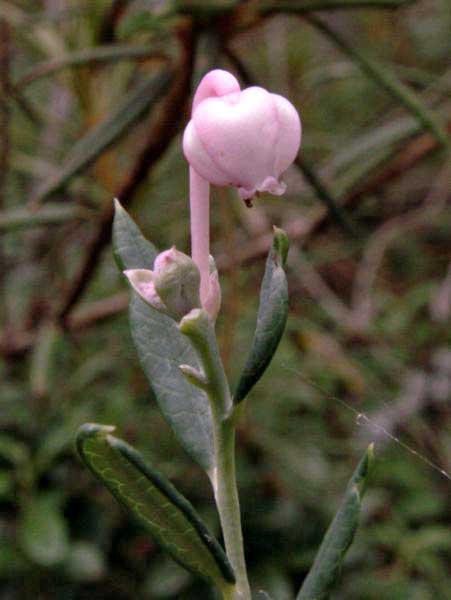
Andromeda polifolia (*)
Classification System: APG IV
Superregnum: Eukaryota
Regnum: Plantae
Cladus: Angiosperms
Cladus: Eudicots
Cladus: Core eudicots
Cladus: Asterids
Ordo: Ericales
Familia: Ericaceae
Subfamilia: Vaccinioideae
Tribus: Andromedeae
Genus: Andromeda
Species: Andromeda polifolia
Subspecies: A. p. subsp. polifolia – A. p. subsp. pumila
Varietas: A. p. var. pumila
Name
Andromeda polifolia L. (1753)
References
Linnaeus, C. 1753. Species plantarum, exhibentes plantas rite cognitas, ad genera relatas, cum differentiis specificis, nominibus trivialibus, synonymis selectis, locis natalibus, secundum systema sexuale digestas. Tomus I. Pp. [I–XII], 1–560. Impensis Laurentii Salvii, Holmiae [Stockholm]. BHL Reference page. : 393.
Links
Hassler, M. 2020. Andromeda polifolia. World Plants: Synonymic Checklists of the Vascular Plants of the World In: Roskovh, Y., Abucay, L., Orrell, T., Nicolson, D., Bailly, N., Kirk, P., Bourgoin, T., DeWalt, R.E., Decock, W., De Wever, A., Nieukerken, E. van, Zarucchi, J. & Penev, L., eds. 2020. Species 2000 & ITIS Catalogue of Life. Published online. Accessed: 2020 May 23. Reference page.
Govaerts, R. et al. 2020. Andromeda polifolia in Kew Science Plants of the World online. The Board of Trustees of the Royal Botanic Gardens, Kew. Published online. Accessed: 2020 May 23. Reference page.
International Plant Names Index. 2020. Andromeda polifolia. Published online. Accessed: May 23 2020.
Tropicos.org 2020. Andromeda polifolia. Missouri Botanical Garden. Published online. Accessed: 23 May 2020.
USDA, ARS, Germplasm Resources Information Network. Andromeda polifolia in the Germplasm Resources Information Network (GRIN), U.S. Department of Agriculture Agricultural Research Service.
Vernacular names
беларуская: Імшарніца, Andromeda
català: Romaní de torbera, Andromeda
kaszëbsczi: Przesôk
čeština: kyhanka sivolistá, kyhanka bažinná
Cymraeg: Andromeda'r gors
dansk: Almindelig Rosmarinlyng, Rosmarinlyng
Deutsch: Rosmarinheide, Gränke, Poleirosmarinheide, Polei-Gränke, Sumpfrosmarin
English: bog-rosemary, marsh rosemary, bog rosemary
español: andromeda
eesti: Küüvits
suomi: Suokukka
français: Andromède
magyar: közönséges tőzegrozmaring
日本語: ヒメシャクナゲ, ヒメシャクナゲ属
lietuvių: Siauralapė balžuva, Andromeda, Balžuva
latviešu: Daudzlapu andromeda, Polijlapu andromēda, Polijlapu andromeda, Daudzlapu andromēda
norsk bokmål: Hvitlyng
Nederlands: Lavendelhei, Lavendelheide
norsk nynorsk: Kvitlyng
norsk: Kvitlyng, hvitlyng
polski: modrzewnica zwyczajna, Modrzewnica północna, Modrzewnica pospolita
português: Andromeda
русский: Белолистник, Бесплодница, Бесплодный куст, Дикий розмарин, Подбел дубровниколистный, Подбел многолистный, Подбел обыкновенный, Пьяный болотник, Тундрица, Чахоточная трава
davvisámegiella: Alášrássi
slovenčina: andromédka sivolistá
svenska: Rosling, Daggrosling, Roslingsläktet
українська: Андромеда багатолиста, Підбіл багатолистий, Підбіл лікарський, Андромеда білоповстиста, Кремена лікарські, Безплідниця, Андромеда, Дібровник
Andromeda polifolia, common name bog-rosemary,[2] is a species of flowering plant in the heath family Ericaceae, native to northern parts of the Northern Hemisphere. It is the only member of the genus Andromeda, and is only found in bogs in cold peat-accumulating areas.
Description
It is a small shrub growing to 10–20 cm (4–8 in) (rarely to 40 cm or 16 in) tall with slender stems. The leaves are evergreen, alternately arranged, lanceolate, 1–5 cm (1⁄2–2 in) long and 2–8 mm (0.08–0.31 in) broad, dark green above (purplish in winter) and white beneath with the leaf margins curled under. The flowers are bell-shaped, white to pink, 5–8 mm (0.20–0.31 in) long; flowering is in late spring to early summer. The fruit is a small capsule containing numerous seeds.
There are two varieties, treated as distinct species by some botanists:
Andromeda polifolia var. polifolia. Northern Europe and Asia, northwestern North America.
Andromeda polifolia var. latifolia Aiton [1789]. Northeastern North America (syn. A. glaucophylla Link [1821], A. polifolia var. glaucophylla (Link) DC. [1839]).[3]
Etymology
The genus was named by Carl Linnaeus who observed it during his 1732 expedition to Lapland and compared the plant to Andromeda from Greek mythology. The specific epithet is a noun in apposition, which Linnaeus based on Johann Christian Buxbaum's pre-Linnaean generic designation Polifolia.[4] Buxbaum in turn derived the name from Johann Bauhin, who used it to mean "having polium-like leaves". The precise plant that Bauhin meant by polium is uncertain, but it may have been Teucrium montanum.[5] The common name "bog rosemary" derives from the superficial resemblance of the leaves to those of rosemary, which is not closely related.
Fossil record
Many fossil seeds of †Andromeda carpatica have been extracted from borehole samples of the Middle Miocene fresh water deposits in Nowy Sacz Basin, West Carpathians, Poland.[6]
Cultivation
Numerous cultivars have been developed for garden use, all of which require damp acid soil in shade. The cultivars 'Compacta'[7] and 'Macrophylla'[8] have gained the Royal Horticultural Society's Award of Garden Merit. Like most other members of the family Ericaceae, they are acid-loving plants (calcifuges), and must be grown in a medium with a low pH.
Chemistry
Bog rosemary contains grayanotoxin, which when ingested may cause respiratory problems, dizziness, vomiting, or diarrhoea.[9]
Images
Andromeda polifolia var. polifolia leaves
Andromeda polifolia, Pancake Bay, Ontario
Illustration
Linnaeus' original drawing
References
Maiz-Tome, L. (2016). "Andromeda polifolia". The IUCN Red List of Threatened Species. IUCN. 208. e.T64263821A67728518. doi:10.2305/IUCN.UK.2016-1.RLTS.T64263821A67728518.en.
BSBI List 2007 (xls). Botanical Society of Britain and Ireland. Archived from the original (xls) on 2015-06-26. Retrieved 2014-10-17.
"Andromeda polifolia L. var. latifolia Aiton". Germplasm Resources Information Network (GRIN). Agricultural Research Service (ARS), United States Department of Agriculture (USDA).
Turland, N.J.; et al., eds. (2018). "Art. 60.10". International Code of Nomenclature for algae, fungi, and plants (Shenzhen Code) adopted by the Nineteenth International Botanical Congress Shenzhen, China, July 2017 (electronic ed.). Glashütten: International Association for Plant Taxonomy. Retrieved 2019-03-07..
Nelson, E. Charles; Oswald, P.H. (2005). "Polifolia revisited and explained" (PDF). Huntia: A Journal of Botanical History. 12 (1): 5–11.
Macroscopic plant remains from the freshwater Miocene of the Nowy Sącz Basin (West Carpathians, Poland) by Łańcucka-Środoniowa M, Acta Palaeobotanica 1979 20 (1): 3-117.
"RHS Plant Selector - Andromeda polifolia 'Compacta'". Retrieved 23 February 2020.
"RHS Plant Selector - Andromeda polifolia 'Macrophylla'". Retrieved 23 February 2020.
Paul Alaback; Joe Antos; Trevor Goward; Ken Lertzman; Andy MacKinnon; Jim Pojar; Rosamund Pojar; Andrew Reed; Nancy Turner; Dale Vitt (2004). Jim Pojar; Andy MacKinnon (eds.). Plants of the Pacific Northwest Coast (Revised ed.). Vancouver: Lone Pine Publishing. p. 53. ISBN 978-1-55105-530-5.
Retrieved from "http://en.wikipedia.org/"
All text is available under the terms of the GNU Free Documentation License

